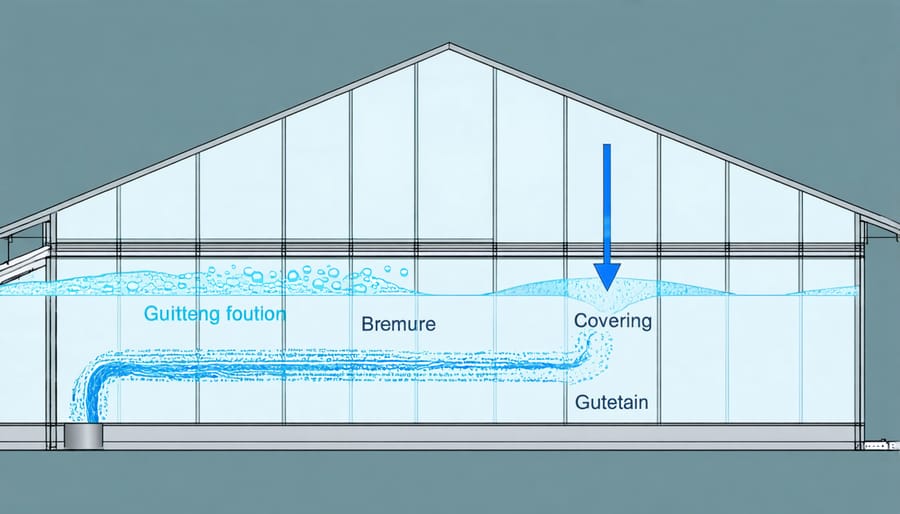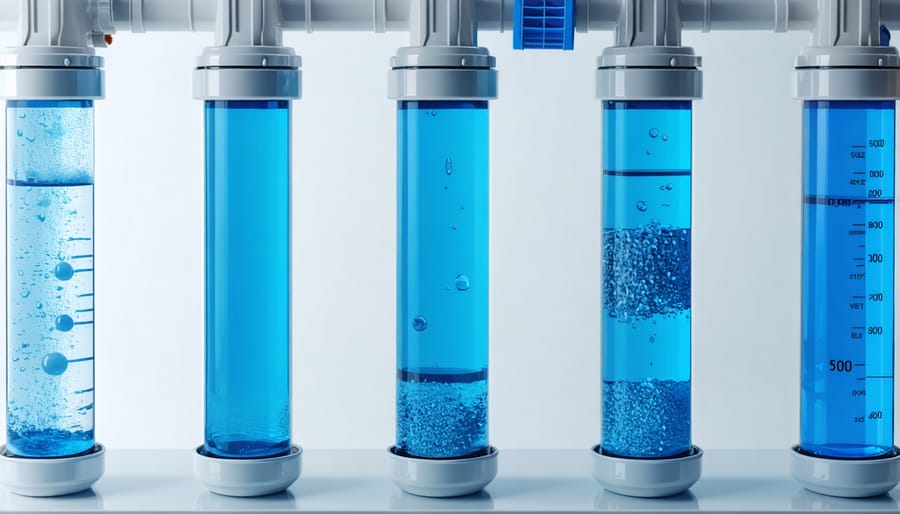
Turn Your Greenhouse Into a Water-Saving Powerhouse: DIY Collection System That Actually Works
Harvest free, sustainable water for your greenhouse while helping to transform your water garden into a self-sustaining ecosystem. A well-designed greenhouse water collection system captures rainwater from your greenhouse roof, filters it through sustainable materials, and stores it for year-round use – reducing water bills by up to 60% while providing optimal hydration for your plants.
Connect standard guttering along your greenhouse eaves, directing water flow into food-grade storage tanks positioned strategically at ground level. Install a first-flush diverter to remove initial roof contaminants, ensuring only clean water enters your system. Add a simple solar-powered pump to distribute collected water through drip irrigation lines, maintaining consistent moisture levels while minimizing waste.
This integrated approach not only supports sustainable gardening practices but also creates a reliable water source during dry spells. Whether you’re growing delicate orchids or hardy vegetables, a greenhouse water collection system delivers pure, temperature-balanced water while reducing your environmental impact and supporting long-term garden success.
Why Your Greenhouse is Perfect for Water Collection
Natural Water Flow Patterns
Water naturally flows in predictable patterns within a greenhouse environment, following the basic principles of gravity and condensation. During the day, warm air rises, carrying moisture that collects on the greenhouse roof and walls. As temperatures cool, this moisture condenses and flows downward, creating natural collection points. Understanding these patterns is essential for implementing effective water-saving gardening techniques.
The sloped roof of a greenhouse directs water toward gutters, while interior condensation typically runs down walls and drips from high points. This natural movement can be harnessed by strategically placing collection vessels or creating channels that direct water flow. Ground-level water movement is influenced by soil composition and surface gradients, which you can modify to guide water toward desired collection areas.
By working with these natural patterns rather than against them, you can maximize water collection efficiency while minimizing the need for artificial pumping systems.

Collection Potential Calculator
To calculate your greenhouse’s water collection potential, start by measuring your greenhouse’s roof area in square feet. Multiply the length by the width to get the total surface area. For every inch of rainfall, you can collect approximately 0.6 gallons of water per square foot of roof area.
For example, if your greenhouse measures 10 feet by 12 feet, your roof area is 120 square feet. With one inch of rainfall, you could collect roughly 72 gallons of water (120 sq ft × 0.6 gallons). To estimate your monthly collection potential, multiply this number by your area’s average monthly rainfall.
Remember that collection efficiency isn’t 100% due to factors like evaporation and system losses. A good rule of thumb is to reduce your calculated amount by 10-15% for a more realistic estimate. Consider your local climate patterns and seasonal variations when planning your storage capacity.
Setting Up Your Collection System

Essential Components
To build an effective greenhouse water collection system, you’ll need several key components that work together to capture and store rainwater. The foundation of your system starts with guttering, which should be sturdy and properly sized for your greenhouse. Choose UV-resistant PVC or aluminum gutters, along with matching downspouts and connectors.
For water storage, you’ll need one or more collection tanks. These can range from simple rain barrels to larger storage tanks, depending on your needs. Look for food-grade containers that are UV-protected to prevent algae growth. Don’t forget to include a secure lid to keep out debris and prevent mosquito breeding.
Essential filtration components include:
– First-flush diverter to remove initial dirty runoff
– Leaf screens for gutters
– Mesh filters for downspouts
– Sediment filter for the storage tank
You’ll also need basic tools for installation:
– Drill and bits
– Level
– Measuring tape
– Screwdriver set
– Hacksaw
– Waterproof sealant
For the distribution system, gather:
– Water pump (if needed for pressure)
– Garden hose connections
– PVC pipes and fittings
– Timer system (optional)
– Overflow valve
Don’t forget safety equipment like work gloves, safety glasses, and a sturdy ladder. Having these components ready before starting will ensure a smooth installation process.
Installation Steps
Before starting the installation, gather all necessary materials: guttering, downspouts, collection tanks, filters, and basic tools like a drill, screwdriver, and level. Always wear safety glasses and gloves during installation.
Begin by planning your gutter placement. Mount brackets along your greenhouse eaves, spacing them every 2-3 feet for proper support. Ensure they slope gently (about 1/4 inch per 10 feet) toward your planned downspout location to encourage water flow.
Next, attach the guttering to the brackets, working from one end to the other. Join sections using connectors and waterproof sealant to prevent leaks. Install end caps at the termination points.
Position your water collection tank on a stable, level surface. A concrete pad or compacted gravel base works well. The tank should sit elevated if you plan to use gravity for water distribution. Install an overflow pipe near the top to direct excess water away from your greenhouse foundation.
Connect the downspout to your guttering using appropriate fittings. Add a first-flush diverter and mesh filter to prevent debris and initial roof runoff from entering your tank. This helps maintain clean water for your plants.
Install a tap or pump system at the tank’s base for easy water access. If using multiple tanks, connect them with linking kits to increase storage capacity.
Finally, test the system by running water through the gutters to check for leaks and proper flow. Make adjustments to brackets and seals as needed.
Remember to conduct regular maintenance checks, especially before rainy seasons, to ensure your system continues working efficiently.
Storage Solutions
When it comes to storing your collected greenhouse water, you’ve got several practical options to choose from. Rain barrels are the most common and budget-friendly choice, typically holding 50-100 gallons each. For larger storage needs, consider installing underground cisterns, which can store hundreds or even thousands of gallons while keeping your greenhouse area tidy.
Above-ground tanks are another excellent option, available in various sizes and materials. Polyethylene tanks are lightweight and affordable, while metal tanks offer durability but may require more maintenance. For a more natural look, you might consider a lined pond that doubles as both water storage and an attractive landscape feature.
If space is limited, slim-line tanks can be positioned against your greenhouse walls, making efficient use of narrow spaces. For areas with freezing winters, insulated tanks or underground storage systems help prevent water from freezing and maintain year-round availability.
Remember to position your storage solution where it can easily collect water from your greenhouse gutters and consider installing an overflow system to manage excess water during heavy rainfall.
Integrating With Your Water Garden
Filtration Methods
Keeping your collected rainwater clean is essential for healthy plant growth in your greenhouse. A multi-stage filtration system ensures your water remains free from debris and harmful contaminants. Start with a simple mesh screen at your collection points to catch leaves and large debris. This first-line defense prevents clogging and makes maintenance easier.
Next, incorporate a sediment filter to remove smaller particles like dirt and sand. A basic DIY solution involves creating layers using gravel, sand, and activated charcoal in a large container. The water passes through these layers, becoming progressively cleaner. For more efficient filtration, consider adding a small mechanical filter system similar to those used in ponds.
Bio-filtration is another excellent option that uses beneficial bacteria to break down organic matter. Creating a small reed bed or installing aquatic plants in your collection tank naturally purifies the water while adding visual interest to your setup.
Remember to check and clean your filters regularly, especially after heavy rainfall. A quick monthly maintenance routine keeps your system running smoothly. If you’re storing water for extended periods, consider adding a small solar-powered circulation pump to prevent stagnation.
For those in areas with high pollution, installing a UV filter provides extra protection against harmful microorganisms, though this isn’t usually necessary for most greenhouse applications.

Distribution Systems
Once you’ve collected rainwater in your greenhouse system, distributing it effectively throughout your garden is crucial. The most efficient approach combines gravity-fed and automated systems, working with natural water garden design principles to maximize every drop.
Start with a main distribution line from your storage tank, ideally positioned at a slight downward angle. From here, you can branch out using various methods:
Drip irrigation is perfect for delivering water directly to plant roots, reducing waste through evaporation. Install adjustable drippers near each plant, connecting them to the main line with flexible tubing.
Soaker hoses work wonderfully for rows of plants or garden beds. Simply weave them through your growing areas, and they’ll slowly release water into the soil. This method is particularly effective for deep-rooted plants.
For smaller greenhouses, consider using a watering wand connected to your storage tank. This gives you precise control over water distribution and lets you adjust watering based on individual plant needs.
Remember to include shut-off valves at key points in your system. This allows you to control water flow to different areas and makes maintenance easier. For added convenience, install a simple timer system to automate watering schedules, ensuring your plants receive consistent moisture even when you’re away.
Maintenance and Troubleshooting
Seasonal Care
Different seasons bring unique challenges for your greenhouse water collection system, requiring specific maintenance to keep it running efficiently. In spring, clean your gutters and filters thoroughly to remove fallen blossoms and winter debris. Check all connections and seals, as winter temperatures may have caused some components to contract or expand.
Summer maintenance focuses on preventing algae growth in your collection tanks. Consider adding floating covers or installing shade cloth to reduce direct sunlight exposure. Regular cleaning of filters becomes especially important during this season when rainfall might carry more organic matter.
Fall brings its own set of tasks, primarily dealing with falling leaves. Install gutter guards if you haven’t already, and check them regularly. This season is also ideal for system upgrades and repairs before winter sets in, making it an excellent time to expand your sustainable garden systems.
Winter requires protecting your system from freezing. Insulate exposed pipes and consider installing heat tape on crucial components. If you live in an area with heavy snowfall, regularly clear snow from your greenhouse roof to prevent structural stress and maintain optimal water collection. Empty collection tanks to about 80% capacity to allow for expansion if freezing occurs.
Common Issues and Solutions
Even well-designed greenhouse water collection systems can face occasional challenges. Clogged gutters from leaves and debris are a common issue, but regular cleaning and installing gutter guards can prevent this problem. Algae growth in storage tanks might occur, especially in warmer months – adding a small amount of beneficial bacteria or using tank covers can help maintain water quality.
Some gardeners notice uneven water distribution due to improper slope in their collection pipes. This can be fixed by adjusting the pipe angles or adding additional support brackets. During heavy rainfall, overflow problems might arise if the storage capacity isn’t sufficient. Installing an overflow valve or connecting additional storage tanks can resolve this issue.
Leaks are another concern, particularly at pipe joints or tank connections. Regular inspections and prompt repairs using waterproof sealant will keep your system running efficiently. In winter, freezing can damage pipes and tanks in colder regions. Insulating exposed pipes and partially draining the system before frost sets in will protect your investment.
If you notice mosquito breeding in standing water, adding mosquito dunks or ensuring proper circulation can effectively address this issue. Remember, most problems are preventable with regular maintenance and early intervention.
A greenhouse water collection system is truly a game-changer for any gardening enthusiast looking to create a more sustainable and efficient growing environment. By implementing this system, you’ll not only reduce your water bills but also contribute to environmental conservation while ensuring your plants receive the best possible care. The natural cycle of collecting, storing, and utilizing rainwater creates a self-sustaining ecosystem that benefits both your greenhouse and any connected water features.
The benefits extend far beyond just water savings. You’ll notice improved plant health thanks to naturally soft rainwater, reduced dependency on municipal water supplies, and the satisfaction of knowing you’re practicing environmentally responsible gardening. Plus, the system can be customized to fit any greenhouse size or budget, making it accessible to both beginner and experienced gardeners alike.
If you’ve been considering a greenhouse water collection system, there’s no better time to start than now. The initial setup might require some planning and effort, but the long-term rewards far outweigh the investment. Whether you’re growing vegetables, maintaining tropical plants, or simply looking to make your greenhouse more efficient, a water collection system will serve as a valuable addition to your gardening setup.
Remember, every drop counts, and by harvesting rainwater, you’re not just creating a more sustainable garden – you’re setting an example for future generations of gardeners. Take that first step today and transform your greenhouse into a model of water efficiency and sustainable gardening practices.
